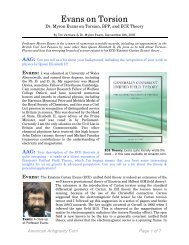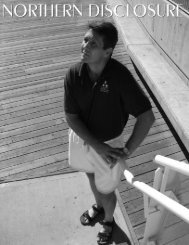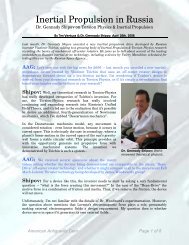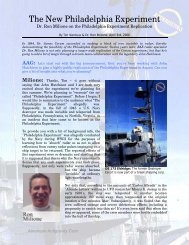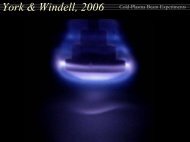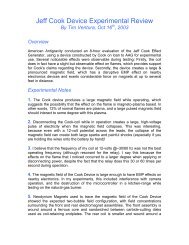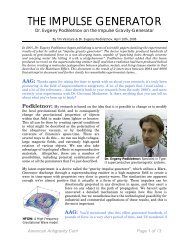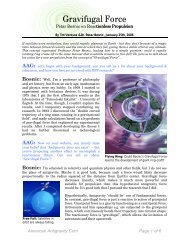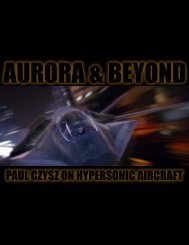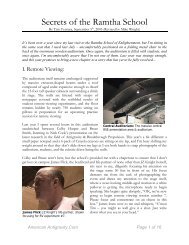Sharon-Weinberger-In.. - American Antigravity
Sharon-Weinberger-In.. - American Antigravity
Sharon-Weinberger-In.. - American Antigravity
You also want an ePaper? Increase the reach of your titles
YUMPU automatically turns print PDFs into web optimized ePapers that Google loves.
It’s not the vaporware per se that makes this an underworld, but the very odd culture of<br />
technology and national security. I don’t draw a line between the perverse and the normal<br />
cultures of defense technology—the two are intertwined because we are all so insulated from the<br />
outside world. I was inspired to try to describe this underworld—and my experience being in it—<br />
to others.<br />
AAG: My understanding is that while you examine several technologies in "Imaginary<br />
Weapons", the core story really involves something called hafnium-bomb, which you first heard<br />
about in a defense-briefing on Capitol Hill in 1998. Can you give us a bit of detail about the<br />
scope of technologies that you focus on in the book, and what it was about the hafnium bomb in<br />
particular that made it so central to this story?<br />
<strong>Weinberger</strong>: The book talks about some of<br />
the more controversial areas of science that have<br />
attracted military interest, including remote<br />
viewing (psychics), cold fusion and antimatter<br />
weapons. I do not list these areas with the idea of<br />
lumping them together as bad science, but rather,<br />
to point out how each of these subjects tends to<br />
attract support from the underworld.<br />
At one point, I considered writing this book as a<br />
collection of stories about the scientific<br />
underworld, but the feedback I got was: “You need<br />
a narrative to carry the reader long.” <strong>In</strong> that sense,<br />
the hafnium bomb is a trope for a larger story I was<br />
trying to tell about technology and national<br />
security.<br />
AAG: Speaking of the hafnium-bomb, I thought<br />
the idea sounded reasonable until I saw your<br />
website, which featured a "hafnium grenade"<br />
claimed to deliver a 2-kiloton yield. Now from a<br />
layman's perspective, my first thought is that a<br />
nuclear hand-grenade has some immediately<br />
obvious drawbacks to deployment, so how’d this<br />
one make it that far up the chain of command?<br />
Hafnium Grenade: A hand-grenade<br />
claiming to deliver a 2-kiloton nuclear blast?<br />
<strong>Weinberger</strong>: Lots of ideas sound reasonable until you look at the practical implications.<br />
To be fair, the Defense Advanced Research Projects Agency (DARPA), in its official briefings to<br />
Congress about hafnium, described the power of a 2,000 pound bomb in the package of a 50<br />
pound bomb. But even that is impractical, and, according to the experts, simply not feasible.<br />
AAG: Now to turn the question around a bit, I've heard rumors that Los Alamos has been<br />
playing with laser-triggered nuclear isomers for years: at least in the context of a quasi-stable<br />
fuel-pellet for use in nuclear space propulsion. Is it possible that this particular idea made it past<br />
the screeners because of simple name-recognition and maybe just a lack of close-scrutiny on the<br />
proposed implementation, or is the entire nuclear-isomer thing just a fish-story?<br />
<strong>Weinberger</strong>: Yes, Los Alamos has been a “hot bed” for nuclear isomer enthusiasts,<br />
although some of them may have retired by now. But it’s important to differentiate between<br />
<strong>American</strong> <strong>Antigravity</strong>.Com Page 3 of 11



